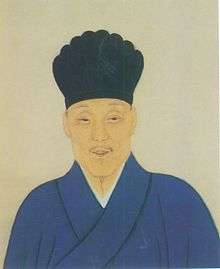Zheng Jing
Zheng Jing, Prince of Yanping (Chinese: 鄭經; Pe̍h-ōe-jī: Tēⁿ Keng; 25 October 1642 – 17 March 1681), courtesy names Xianzhi (賢之) and Yuanzhi (元之), pseudonym Shitian (式天), was a 17th-century Chinese warlord, Ming dynasty loyalist and ruler of the Kingdom of Tungning in Taiwan.
| Zheng Jing 鄭經 | |||||||||||||
|---|---|---|---|---|---|---|---|---|---|---|---|---|---|
| Prince of Yanping | |||||||||||||
 | |||||||||||||
| Ruler of the Tungning | |||||||||||||
| Reign | November 1662 – 17 March 1681 | ||||||||||||
| Predecessor | Zheng Xi | ||||||||||||
| Successor | Zheng Kezang | ||||||||||||
| Born | 25 October 1642[1] Nan'an, Fujian, Great Ming[2] | ||||||||||||
| Died | 17 March 1681 (aged 38)[3] Chengtian Fu, Tungning | ||||||||||||
| Spouse | Tang, Princess Wen of Chao | ||||||||||||
| Issue | Zheng Kezang, Zheng Keshuang, six other sons and six daughters | ||||||||||||
| |||||||||||||
| House | The House of Koxinga | ||||||||||||
| Father | Koxinga, Prince of Yanping | ||||||||||||
| Mother | Dong You, Princess of Yanping | ||||||||||||
| Zheng Jing | |
| Hàn-jī | 鄭經 |
|---|---|
| Pe̍h-ōe-jī | Tēⁿ Keng |
| Tâi-lô | Tēnn King |
| Pen name | |
| Hàn-jī | 式天 |
| Pe̍h-ōe-jī | Sek-thian |
| Tâi-lô | Sik-thian |
| Courtesy name | |
| Hàn-jī | 賢之 / 元之 |
| Pe̍h-ōe-jī | Hiân-chi / Goân-chi |
| Tâi-lô | Hiân-tsi / Guân-tsi |
History
Born in 25 October 1642, he was the eldest son of Koxinga (Zheng Chenggong) and a grandson of the pirate-merchant Zheng Zhilong. After the conquest of Fort Zeelandia in 1662 by his father, Zheng Jing controlled the military forces in Xiamen and Quemoy on his father's behalf. Upon the death of his father six months later, Zheng Jing contested throne as the King of Tungning with his uncle, Zheng Shixi. The dispute was resolved in Zheng Jing's favor after he successfully landed an army in Taiwan despite strong opposition by the forces of his uncle. This was followed by Zheng Shixi withdrawing his claim.
With both the vast pirate fleet and the throne of Tungning, he intended to continue his father's plans to invade the Philippines; however, he was forced to abandon this venture when faced with the threat of a Manchu-Dutch alliance. His defeat over to a combined Qing-Dutch fleet commanded by Han Banner General Ma Degong in 1664 resulted in ending the brief alliance. Ma Degong was killed in the battle by Zheng's fleet.
The Dutch looted relics and killed monks after attacking a Buddhist complex at Putuoshan on the Zhoushan islands in 1665 during their war against Zheng Chenggong's son Zheng Jing.[4]
Zheng Jing's navy executed thirty four Dutch sailors and drowned eight Dutch sailors after looting, ambushing and sinking the Dutch fluyt ship Cuylenburg in 1672 on northeastern Taiwan. Only twenty one Dutch sailors escaped to Japan. The ship was going from Nagasaki to Batavia on a trade mission.[5]
For the next 19 years, he tried to provide sufficiently for the local inhabitants and reorganizing their military forces in Taiwan. He frequently exchanged ambassadors with the Kangxi Emperor from the mainland. Although he continued to fight for the cause his father died for, he had largely abandoned any pretense of restoring the Ming dynasty by the time he invaded Fujian in 1676. Zheng's forces land in Siming at the behest of Geng Jingzhong, who has joined the Revolt of the Three Feudatories, following the lead of Wu Sangui.[6] He occupied key cities in the province for a year before losing them back to the Manchus by the end of 1677. Invading Fujian once more, he led a force of 30,000 men to capture Haicheng as well as taking the provincial commander prisoner.
In 1680, Zheng Jing was forced to abandon Xiamen, Quemoy and Dongshan after losing a major naval battle to Chinese Qing admiral Shi Lang. Driven off the mainland by the Manchus, he retreated to modern-day Tainan where he fell ill and died of dissipation on 17 March 1681. Zheng named as his successor his oldest son, Zheng Kezang; however, Zheng Kezang was quickly toppled in favor of Zheng Keshuang.
See also
- Kingdom of Tungning
- History of Taiwan
- Zheng Chenggong
- Shi Lang
References
- Hung (1981), p. 139. (See note 1 for the source; a stone epitaph on Zheng's tomb.)
- Hung (1981), p. 139.
- Hung (1981), p. 265.
- Hang, Xing (2016). Conflict and Commerce in Maritime East Asia: The Zheng Family and the Shaping of the Modern World, c.1620–1720. Cambridge University Press. p. 154. ISBN 1316453847.
- Hang, Xing (2016). Conflict and Commerce in Maritime East Asia: The Zheng Family and the Shaping of the Modern World, c.1620–1720. Cambridge University Press. p. 190. ISBN 1316453847.
- The Brilliant Reign of the Kangxi Emperor: China's Qing Dynasty
Bibliography
- Carioti, Patrizia. “The Zhengs' Maritime Power in the International Context of the 17th Century Far East Seas: The Rise of a 'Centralised Piratical Organisation' and Its Gradual Development into an Informal 'State'”. Ming Qing Yanjiu (1996): 29-67.
- Chang Hsiu-jung, Anthony Farrington, Huang Fu-san, Ts'ao Yung-ho, Wu Mi-tsa, Cheng Hsi-fu, and Ang Ka-in. The English Factory in Taiwan, 1670 - 1685. Taipei: National Taiwan University, 1995.
- Clements, Jonathan. Coxinga and the Fall of the Ming Dynasty. Stroud: Sutton Publishing, 2004.
- Hung, Chien-chao (1981). Taiwan Under the Cheng Family, 1662–1683: Sinicization After Dutch Rule (Ph.D. dissertation). Georgetown University. OCLC 63232462.CS1 maint: ref=harv (link)
- Keene, Donald Keene. The Battles of Coxinga: Chikamatsu’s Puppet Play, Its Background and Importance. London: Taylor’s Foreign Press, 1950.
- Manthorpe, Jonathan. Forbidden Nation: a History of Taiwan, New York: Palgrave MacMillan, 2002.
- Shen Yu. Cheng-shih shih-mo. 1836.
- Wills, Jr., John E. Pepper, Guns and Parleys: The Dutch East India Company and China 1622-1681. Cambridge: Harvard University Press, 1974.
Zheng Jing Born: 25 October 1642 Died: 17 March 1681 | ||
| Regnal titles | ||
|---|---|---|
| Preceded by Koxinga |
Prince of Yanping November 1662 – 17 March 1681 |
Succeeded by Zheng Keshuang |
| Political offices | ||
| Preceded by Zheng Xi |
Ruler of the Kingdom of Tungning November 1662 – 17 March 1681 |
Succeeded by Zheng Kezang |
